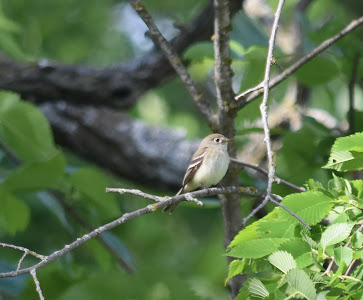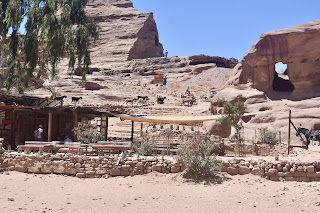So you may recall our hotel was right next to the Petra archaeological site.

It was a lovely, elegant place with clean rooms and minimalist decor.
We had a magnificent dinner and breakfast buffet served on carts with Arab-influenced designs.

It seems like pastries were a big thing everywhere we went!
And there was this vivid pink cauliflower/pickle
Not a bad picture of yours truly riding the elevator at the hotel!

So the morning of September 10th we headed down to the lobby and over to the Petra site.
Petra is famous to many Americans from scenes shot in one of the Indiana Jones movies.
It was a huge place 102 square miles according to wikipedia.
After you enter the grounds, there are a lot of horses that you pass before seeing some of the earliest caves and the Djinn blocks.
Most of these pictures are not in particular order, but the sights are truly awe-inspiring.
There are actually different kinds of terrain in the park.
This is a fairly long walk (especially when you are heading back to the hotel!) ;-)
The first area one encounters is an area with large blocks of stone.
These Djinn blocks were tombs about 400 meters after the entrance to the park.
There are about 26 of them. The Bedouins say that ghosts or djinn lived in them.
People lived in many of these caves until the area was made into a park.
On the south we also saw the so-called Obelisk tomb and triclinium. The pointy structures on the top of the tomb are not obelisks, but nefeshes (a pillar like stone used as a kind of grave marker). Beneath the Obelisk tomb is the Triclinum Bab as-siq. (Door of the Siq). A triclinium is a kind of dining hall with three benches (the trim in triclinium) used to honor the dead.
After passing the Djinn blocks, we walked through a passage with amazing rock formations. This is the Siq. Here is a Google earth Map of the path. The red dot is the Obelisk tomb.
The colors in the rocks are magnificent and change with the light.
The area was inhabited by the very early civilization, the Nabataeans (perhaps as early as 7000 BC).
Not too much is known about the Nabataeans, that settled here. They were evidently not mentioned in the Bible per se, but we were shown some evidences of their civilization as we progressed deeper into the park.
Along this path we also could see traces of a water system (above) for transporting water into the interior of the area.
We took dozens of pictures of the Siq, because it was just so impressive in size and variety of color.
There were tombs interspersed throughout the walkway.
Here is the obligatory elephant rock vista.
This walk alone was wondrous enough without the amazing monuments to come!
This area would become their capital city in the 4th century BC.
The Nabataeans were nomadic Arabs that prospered due to the trade routes for incense. They inhabited the East bank of the Jordan river and we have pottery from them with thin walls with floral designs.
Wikipedia has these examples photographed by Bjornpa.
There are 8 different kinds of facades identified several strongly influenced by Hellenic and Roman styles.
There are some examples of Nabataean sculpture and painting, but most of this in Petra has been effaced by the elements. Here is one figural remnant. It looks like it might have been a camel driver with a caravan of camels at one time. You can see camel feet next to a partial figure of a man and a camel belly and possibly even back shape above the feet.
The most famous edifice in Petra is the "Treasury" a large building carved into the red rocks there. As you approach it, you cannot see that something magnificent is directly ahead of you.
The path to the "Treasury," al Khazneh, (الخزنة) is through a passage and then you get to the opening and there it is: a large kind of plaza amidst the cliffs. Although many of the structures at Petra stem from the 1st century BC, this one seems to be an elaborate tomb cut during the rule of Aretas IV Philopatris in the 1st century CE (early in the century - like 2-40 CE) . His daughter was married to Herod the Tetrarch (yes, I think this was THE King Herod in the New Testament - there were a heckuva lot of Herods at that time!) Herod Antipas wanted to marry his brother (Herod II, of course)'s wife (Herodias, what else!) You might remember that John the Baptist's opposition to this marriage lost him his head.
So... there it was!
You come out of the Siq passage and the huge tomb is right in front of you!
The Bedouins supposedly named the building "the Treasury". Perhaps this was based on an urn carved into the sandstone.
Anyway this monument is likely a tomb cut into the red sandstone cliffs for Aretas IV "King of the Nabataeans, Friend of his people" as his title insists.
In front of the building there are lots of people with camels for the tourists to ride. The Urn that supposedly contained the Roman treasure is that central cylinder above the tympanum.
The urn is completely solid and could not ever have contained anything. Nonetheless there are many bullet holes testing whether the treasure might not be accessible if the urn were to be opened somehow. If you click on the image you might be able to discern some of them.
One legend says that the Egyptian pharaoh created the place magically when he was chasing Moses.
Unfortunately the interior is now completely empty.
Dennis Jarvis has a better photo on
Wikipedia showing the colors of the interior.
This facade was used in the Indiana Jones and the Last Crusade film (made in 1989) to signify the resting place of the Holy Grail.
There are of course lots of tourists here. (Many, I think turn around after they reach this most famous part of the park.)
We luxuriated in the beauty of the spot and then knew it was time to think about moving on.
Then we headed off to our left (farther to the West) past tall cliffs on our left called "The High Place of Sacrifice." We were tired at that point and took some time to rest at a place for refreshments.

There was a kitty there, who was very friendly.
We were fortunate to be there at pomegranate juice season and it was interesting to watch them fresh-pressing the juice.
The press looked like some kind of an exotic alien machine!
Here is our group enjoying being able to sit for a while.
We passed by the street of Facades, taking a quick glance at the so-called Unayshu (or Uneishu) tomb. This one is a Hegra-type facade.
Universes.art describes it as consisting, "
of a principal order (entablature, a plain attic with mouldings crowned by two large half merlons) which is supported by two pilasters with Nabataean capitals. The door, reached by three steps and flanked by two very narrow pillars supporting an entablature, is optically enlarged by a second frame of pilasters with engaged quarter columns and triangular pediment, where three acroterion bases can still be seen.The almost square funeral chamber (7,90 by 7,60 m) has three loculi in the back wall and four loculi in each of the side walls. Another loculus can be seen on the exterior right wall carved very high."
Continuing down the road, we could look back over our right shoulders and see the impressive grouping of royal tombs.
There are almost 900 tombs scattered about in Petra, but the massing of these large elegant ones together makes them especially imposing.
If you look at the far left side of this image above you can see the Palace tomb. Next to it is the so-called Corinthian tomb. Right above the horses you can also see the "Silk tomb" which has beautiful, colorful striations and the Urn tomb. Here is a closer
view of the Palace and Corinthian tombs from
Worldalldetails.com.
The road that we travelled on heading toward the theater was full of souvenir booths and stalls.
The map doesn't really give us an indication of what the tombs are in this area, but we see the same stair step ornaments and columns as on other buildings.
Then we come to the Roman-style theater (مسرح البتراء). This theater has three tiers of seating carved into the rock. There are seven stairways and seats for roughly 8500 people and is bigger than the Roman theater in Amman that we would stop at later.
The pillars are supposedly Nabataean in character rather than Roman, but there hardly seems enough of them left to tell what they originally looked like.
People wonder whether Aretas IV Philopatris might not have built this mammoth structure to try and compete with some of the giant projects of Herod the Great.
Heading farther down the road we saw this big store with frankincense and myrrh and other local kinds of souvenirs.
All along the way are lots of horses (I think people start to get tired at this point especially when on the way back.)
Of course there was a Starbucks here (although I seriously doubt it is affiliated with the famous franchise!)
Our friend Wayne went in there and we didn't see him or his wife the rest of the day! ;-) I think they arranged some kind of special private tour!
It was a cozy little place (but pretty dark inside when there was no camera flash!)
This was the place to shop, but I had other things on my mind (like whether I would have the stamina or not to make the climb to the Monastery.)
After this point we were headed to an area that had much stronger Roman influence. I'll address this and the trip to the Monastery in the next section of the blog.

































































































































